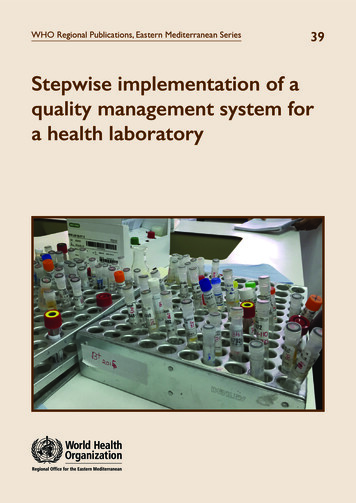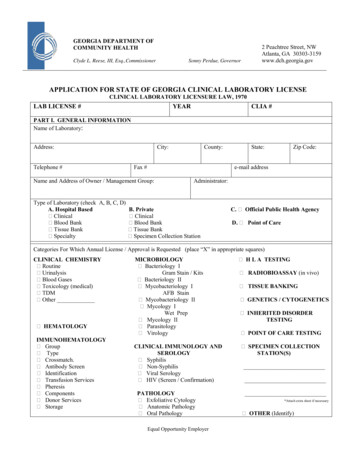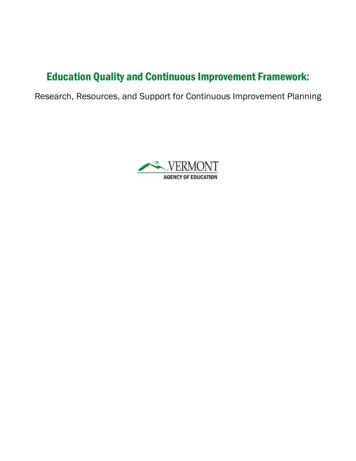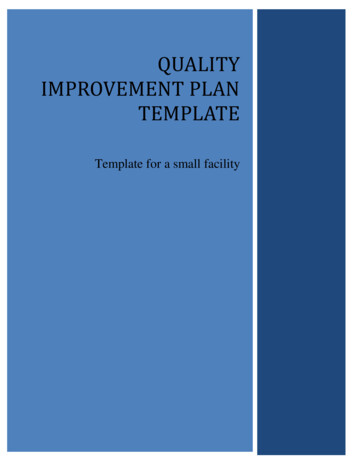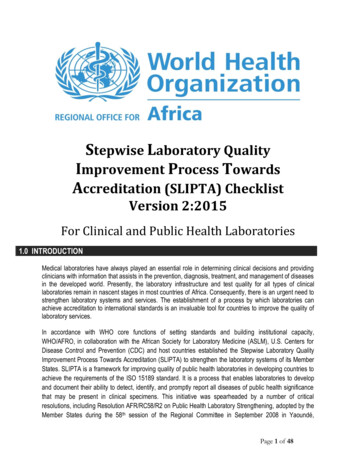
Transcription
Stepwise Laboratory QualityImprovement Process TowardsAccreditation (SLIPTA) ChecklistVersion 2:2015For Clinical and Public Health Laboratories1.0 INTRODUCTIONMedical laboratories have always played an essential role in determining clinical decisions and providingclinicians with information that assists in the prevention, diagnosis, treatment, and management of diseasesin the developed world. Presently, the laboratory infrastructure and test quality for all types of clinicallaboratories remain in nascent stages in most countries of Africa. Consequently, there is an urgent need tostrengthen laboratory systems and services. The establishment of a process by which laboratories canachieve accreditation to international standards is an invaluable tool for countries to improve the quality oflaboratory services.In accordance with WHO core functions of setting standards and building institutional capacity,WHO/AFRO, in collaboration with the African Society for Laboratory Medicine (ASLM), U.S. Centers forDisease Control and Prevention (CDC) and host countries established the Stepwise Laboratory QualityImprovement Process Towards Accreditation (SLIPTA) to strengthen the laboratory systems of its MemberStates. SLIPTA is a framework for improving quality of public health laboratories in developing countries toachieve the requirements of the ISO 15189 standard. It is a process that enables laboratories to developand document their ability to detect, identify, and promptly report all diseases of public health significancethat may be present in clinical specimens. This initiative was spearheaded by a number of criticalresolutions, including Resolution AFR/RC58/R2 on Public Health Laboratory Strengthening, adopted by theMember States during the 58th session of the Regional Committee in September 2008 in Yaoundé,Page 1 of 48
Cameroon, and the Maputo Declaration to strengthen laboratory systems. This quality improvementprocess towards accreditation further provides a learning opportunity and pathway for continuousimprovement, a mechanism for identifying resource and training needs, a measure of progress, and a linkto the WHO/AFRO National Health Laboratory Service Networks.Clinical, public health, and reference laboratories participating in the SLIPTA are reviewed bi-annually.Recognition is given for the upcoming calendar year based on progress towards meeting requirements setby international standards and on laboratory performance during the 12 months preceding the SLIPTAaudit, relying on complete and accurate data, usually from the past 1-13 months to 1 month prior toevaluation. This quality improvement process towards accreditation further provides a learning opportunityand pathway for continuous improvement, a mechanism for identifying resource and training needs, ameasure of progress, and a link to the WHO/AFRO National Health Laboratory Service Networks.The current checklist was updated through a technical expert review process to align it with the ISO15189:2012 version of the standard.2.0 ScopeThis checklist specifies requirements for quality and competency aimed to develop and improve laboratoryservices to raise quality to established national standards. The elements of this checklist are based on ISOstandard 15189:2012 (E) and, to a lesser extent, CLSI guideline QMS01-A4; Quality Management System:A Model for Laboratory Services; Approved Guideline – Fourth Edition.Recognition is provided using a five star tiered approach, based on a bi-annual on-site audit of laboratoryoperating procedures, practices, and performance. The audit checklist score will correspond to the numberof stars awarded to a laboratory in the following manner:No Stars1 Star2 Stars(0 – 150 pts)(151 – 177 pts)(178 – 205 pts) 55%55 – 64%65 – 74%4 Stars5 Stars(206 – 232 pts)(233 – 260 pts)(261 – 275 pts)75 – 84%85 – 94% 95%3 Stars 3.0 Parts of the AuditThis laboratory audit checklist consists of three parts:Part I: Laboratory ProfilePart II: Laboratory AuditsEvaluation of laboratory operating procedures, practices, and tables for reporting performancePart III: Summary of Audit FindingsSummary of findings of the SLIPTA audit and action planning worksheetPage 2 of 48
PART I: LABORATORY PROFILEDate of Audit:Date of Last Audit:Prior Audit StatusNot Audited0 Stars1 Star2 Stars3 Stars4 Stars5 StarsName(s) and Affiliation(s) of Auditor(s)Laboratory Name:Laboratory NumberLaboratory Address:Laboratory Telephone:Fax:Email:Head of Laboratory:Telephone (Head of Laboratory):PersonalWorkLaboratory Level (check only one)Type of Laboratory/Laboratory Affiliation (check only ictZonalFieldResearchNon-hospitalOutpatient ClinicPrivateOther – Please specify:Laboratory Staffing SummaryProfessionNumber of Full TimeEmployeesAdequate for facility operations?Degree-holding Professional StaffYesNoInsufficient DataDiploma-holding Professional StaffYesNoInsufficient DataCertificate-holding Professional StaffYesNoInsufficient DataData ClerkYesNoInsufficient DataPhlebotomistYesNoInsufficient DataCleanerYesNoInsufficient DataIs the cleaner(s) dedicated to the laboratory only?YesNoHas the cleaner(s) been trained in safe waste handling?YesNoYesNoInsufficient DataIs the driver(s) dedicated to the laboratory only?YesNoHas the driver(s) been trained in biosafety?YesNoYesNoInsufficient DataDriverOtherIf the laboratory has IT specialists, accountants or non-laboratory-trained management staff, this should be indicated in the description of theorganizational structure on the following page.Page 3 of 48
PART II: LABORATORY AUDITSLaboratory audits are an effective means to 1) determine if a laboratory is providing accurate and reliable results; 2)determine if the laboratory is well-managed and is adhering to good laboratory practices; and 3) identify areas forimprovement.Auditors complete this audit using the methods below to evaluate laboratory operations per checklist items and todocument findings in detail. Review laboratory documents to verify that the laboratory quality manual, policies, Standard OperatingProcedures (SOPs) and other manuals (e.g., safety manual) are complete, current, accurate, and annuallyreviewed.Review Laboratory Records: Equipment maintenance records; audit trails, incident reports, logs,personnel files, IQC records, EQA recordsObserve laboratory operations to ensure:o laboratory testing follows written policies and procedures in pre-analytic, analytic and post-analyticphases of laboratory testing;o laboratory procedures are appropriate for the testing performed;o Deficiencies and nonconformities identified are adequately investigated and resolved within theestablished timeframe. Ask open-ended questions to clarify documentation seen and observations made. Ask questions like,“show me how ” or “tell me about ” It is often not necessary to ask all the checklist questions verbatim.An experienced auditor can often learn to answer multiple checklist questions through open-endedquestions with the laboratory staff. Follow a specimen through the laboratory from collection through registration, preparation, aliquoting,analysing, result verification, reporting, printing, and post-analytic handling and storing samples todetermine the strength of laboratory systems and operations. Confirm that each result or batch can be traced back to a corresponding internal quality control (IQC)run and that the IQC was passed. Confirm that IQC results are recorded for all IQC runs and reviewed forvalidation. Confirm PT results and the results are reviewed and corrective action taken as required. Evaluate the quality and efficiency of supporting work areas (e.g., phlebotomy, data registration andreception, messengers, drivers, cleaners, IT, ). Talk to clinicians to learn the users’ perspective on the laboratory’s performance. Clinicians often are agood source of information regarding the quality and efficiency of the laboratory. Notable findings can bedocumented in the Summary and Recommendations section at the end of the checklist.Page 4 of 48
AUDIT SCORINGThis Stepwise Laboratory Quality Improvement Process Towards Accreditation Checklist contains 12 main sections (a total of 117questions for a total of 275 points. Each item has been awarded a point value of 2, 3, or 5 points—based upon relative importanceand/or complexity. Responses to all questions must be, “yes”, “partial”, or “no”. Items marked “yes” receive the corresponding point value (2, 3, or 5 points). All elements of a question must bepresent in order to indicate “yes” for a given item and thus award the corresponding points.NOTE: items that include “tick lists” must receive all “yes” and/or “n/a” responses to be marked “yes” for the overarchingitem. Items marked “partial” receive 1 point. Items marked “no” receive 0 points.When marking “partial” or “no”, notes should be written in the comments field to explain why the laboratory did not fulfil this item toassist the laboratory with addressing these areas of identified need following the audit.Where the checklist question does not apply, indicate as NA. Subtract the sum of the scores of all questions marked NA andsubtract that sum of NAs from the total of 275. Since denominator has changed, the star status is then determined using % score.Audit Score SheetSectionTotal PointsSection 1: Documents & Records28Section 2: Management Reviews14Section 3: Organization & Personnel22Section 4: Client Management & Customer Service10Section 5: Equipment35Section 6: Evaluation and Audits15Section 7: Purchasing & Inventory24Section 8: Process Control32Section 9: Information Management21Section 10: Identification of Non Conformities, Corrective and Preventive Actions19Section 11: Occurrence/Incident Management & Process Improvement12Section 12: Facilities and Biosafety43TOTAL SCORE275No Stars1 Star2 Stars(0 – 150 pts)(151 – 177 pts)(178 – 205 pts) 55%55 – 64%65 – 74%4 Stars5 Stars(206 – 232 pts)(233 – 260 pts)(261 – 275 pts)75 – 84%85 – 94% 95%3 StarsPage 5 of 48
For each item, please circle as relevant Not Applicable (NA), Yes (Y), Partial (P) or No (N). All elements of the item must besatisfactorily present to indicate “yes”. Provide explanation or further comments for each “partial” or “no” response.Section 1 : DOCUMENT AND RECORDSRequirement1.1 Legal EntityDoes the laboratory have documentation statingits legal identity?YYPPNNCommentsScore2ISO15189:2012 Clause 4.1.1.2” The laboratory or the organization of which the laboratory is a part shall be an entity that can be held legally responsible for itsactivities. Note: Documentation could be in the form of a National Act, Company registration certificate, License number or Practice numb er.1.2 Laboratory Quality ManualIs there a current laboratory quality manual,composed of the quality management system’spolicies and has the manual content beencommunicated to, understood and implementedby all staff?The quality manual includes the followingelements:a) Quality policy statement that includes scopeof service, standard of service, measurableobjectives of the quality management system,and management commitment to compliance.b) Documented policies for the qualitymanagement system that meet therequirements of ISO15189:2012(Refer to Question 1.5 of this checklist forlist of policies required)c) Description of the quality management systemand the structure of its documentationd) Reference to supporting procedures (SOPs),including managerial and technical procedurese) Description of the roles and responsibilities ofthe laboratory director, or laboratory manager,quality manager, and other key personnel(laboratory to define its key personnel)responsible for ensuring compliancef) Records of review and approval of the qualitymanual by authorized personnelg) Records to show that the quality manual wascommunicated to and understood by the labpersonnelYPN5Tick for each item as Yes (Y),No (N) or Partial (P)YPNISO15189:2012 Clause 4.1.2.3 and 4.2.2.2 and 4.3Note: A quality manual must be available that summarizes the laboratory’s quality management system, which includes policies that a ddress all areas of thelaboratory service, and identifies the goals and objectives of the quality management system. The quality manual must include policies and make reference toprocesses and procedures for all areas of the laboratory service and must address all the clauses of ISO15189:2012.1.3 Document and Information Control SystemDoes the laboratory have a system in place tocontrol all documents and information frominternal and external sources?2YPNISO15189:2012 Clause 4.3Note: There must be a procedure on document control. A document control system must be in place to ensure that records and all documents (internal andexternal) are current, read and understood by personnel, approved by authorized persons, reviewed periodically and revised as required. Documents must beuniquely identified to include title, page numbers, and authority of issue, document number, versions, effective date, and author. Example of external documentsincludes regulations, standards, guidelines, equipment user manuals, package inserts, text books.Page 6 of 48
1.4 Document and RecordsIs there a list that details all documents used inthe quality management system indicating theireditions and distribution?YP2NISO15189:2012 Clause 4.3Note: Documents to be included on the list include Manuals, Procedures, and Processes. Work instructions. Forms, external documents. The list could be in theform of a document master index, document log or document register. “Edition” can be regarded as synonymous with “revision or version” number for thedocuments.1.5 Laboratory Policies and Standard OperatingProceduresAre policies and/or standard operatingprocedures (SOPs) for laboratory functions,technical and managerial procedures current,available and approved by authorizedpersonnel?YP5NISO15189:2012 Clause 4.3 and 5.5Note: The laboratory must define who is authorized to approve documents for its intended use. The approver should not be the author but can be the reviewer.Tick for each item asHas the laboratory defined Policies and/or SOPs thatYes(Y), Partial (P) oraddresses the following:No (N)Ethical ConductHow the laboratory will: 1) minimize activities thatwould diminish confidence in the laboratory'scompetence, impartiality, and judgment; 2) performwork within relevant legal requirements; 3) ensureconfidentiality; 4) handle human samples, tissues ortheir remains as per regulations; 5) identify and avoidpotential conflicts of interest and commercial,financial, political or other pressures that may affectthe quality and integrity of operations?YPNISO15189:2012 Clause 4.1.1.3Note: Laboratories shall uphold the principle that the welfare and interest of the patient are paramount and patients should be tre ated fairly and withoutdiscriminationDocument ControlHow the laboratory will: 1) control all internal andexternal documents; 2) create documents; 3) identifydocuments; 4) review documents; 5) approvedocuments; 6) capture current versions and theirdistribution by means of a list; 7) handle amendments;8) identify changes; 9) handle obsolete documents; 10)retain documents; 11) prevent the unintended use ofany obsolete document; 12) ensure safe disposal ofdocuments?YPNISO15189:2012 Clause 4.3 and 4.13Note: Documents that should be considered for document control are those that may vary based on changes in versions or time. Examples include policy statements,instructions for use, flow charts, procedures, specifications, forms, calibration tables, biological reference intervals and their origins, charts, posters, notices,memoranda, software documentation, drawings, plans, agreements, and documents of external origin such as regulations, standards and text books from whichexamination procedures are taken.Control of RecordsHow the laboratory will: 1) identify; 2) collect; 3)index; 4) access; 5) store; 6) maintain; 7) amends; 8)dispose of safely; 9) define the retention period for theidentified records?YPNISO15189 :2012 Clause 4.13Note: Records can be in any form or type of medium providing they are readily accessible and protected from unauthorized alterations. Legal liability concernsregarding certain types of procedures (e.g. histology examinations, genetic examinations, pediatric examinations) may require the retention of certain records formuch longer periods than for other records. For some records, especially those stored electronically, the safest storage may be on secure media and an offsitelocation. Type of records will include but not be limited to quality records, technical records, personnel records, test request and results records,Page 7 of 48
Communication (internal and external)How the laboratory will: 1) ensure effectivecommunication with staff and users of the laboratory;2) handle staff suggestions for improvement; 3)communicate with stakeholders on the effectiveness ofthe quality management system across all processes; 4)capture records of all communications; 5) retain andmaintain all records of communication, requests,inquiries, verbal discussions and requests for additionalexaminations, meeting agendas, and meeting minutes)?YPNISO15189:2012 Clause 4.1.2.6 and 4.14Note: Laboratory management must ensure that appropriate communication processes are established between the laboratory and its stakeholders and thatcommunication takes place regarding the effectiveness of the laboratory’s pre-examination, examination and post-examination processes and quality managementsystem.Service AgreementsHow the laboratory will: 1) establish serviceagreements; 2) review service agreements; 3) handlewalk in patients (if applicable); 4) inform customersand users of any changes that affect the results of therequisition stated on the service agreement; 5)communicate to the requester of any work that hasbeen referred; 6) retain records of communication?YPNISO15189:2012 Clause 4.4.1 and 5.4Notes: By accepting a requisition form from an authorized requester, the laboratory is considered to have entered into a service agr eement.Customers and users may include clinicians, health care organizations, third party payment organizations or agencies, pharmaceutical companies, and patients.Examination by Referral Laboratories andConsultantsHow the laboratory will: 1) select referral laboratoriesand consultants who provide opinions as well asinterpretations; 2) evaluate and monitor theperformance of referral laboratories and consultantswho provide opinions as well as interpretations; 3)maintain a list of approved referral laboratories andconsultants; 4) maintain a records of referred samples;5) tracking of referred samples and their results; 6)report results from referral labs; 7) package andtransport referred samples; 8) record communicationof results from referral laboratories and consultants?NAYPNISO15189:2012 Clause 4.5 and 5.8 and 4.13Note: The laboratory must have a documented procedure for selecting and evaluating referral laboratories and consultants who provide opinions as well asinterpretation for complex testing in any discipline.External Services and SuppliersHow the laboratory will: 1) select external purchasesand services; 2) establish its selection criteria,including acceptance and rejection criteria; 3) approveand maintain its approved suppliers list; 4) define therequirements of its purchase supplies and services; 5)review and monitor the performance of its approvedsuppliers; 6) establish frequency of reviews?YPNISO15189:2012 Clause 4.6 and 5.3Note: The laboratory must have a documented procedure for the selection and purchasing of external services, equipment, reagents and consumable supplies thataffect the quality of its service.Purchasing and Inventory ControlHow the laboratory will: 1) request, order and receivesupplies; 2) establish acceptance/rejection criteria forpurchased items; 3) store purchased supplies; 4)control their inventory; 5) monitor and handle expiredconsumables?YPNPage 8 of 48
ISO15189 :2012 Clause 4.6 and 5.3.2Note: The laboratory shall have a documented procedure for the reception, storage, acceptance testing and inventory management of reagents and consumables.Advisory ServicesHow the laboratory will: 1) advise on the choice ofexaminations it offers; 2) communicate its advisoryservices to its users; 3) advise on clinical indicationsand limitations of examination procedures; 4) adviseon the frequency of examination; 5 ) provide individualclinical case advice; 6) advise on interpretation ofresults; 7) promote the effective utilization oflaboratory services; 8) provide consultation onscientific and logistic matters; 9) advise on therequired type of sample and volume for testing?YPNPNISO15189:2012 Clause 4.7Note: The laboratory must have a system in place for providing advise to its users.Resolution of Complaints and FeedbackHow the laboratory will: 1) manage complaintsreceived from clinicians, patients, laboratory staff orother parties; 2) collect, receive and handle feedbackreceived from clinicians, patients, laboratory staff orother parties; 3) keep records of all complaints, theinvestigations and actions taken, 4) determine thetimeframe for closure and feedback to the complainant;5) monitor effectiveness of corrective and preventativeactions taken on complaints and feedback?YISO15189:2012 Clause 4.8 and 4.10Note: The laboratory must have a documented procedure for the management of complaints or other feedback received from clinicians, patients, laboratory staff orother parties. Records shall be maintained of all complaints and their investigation and the action takenIdentification and Control of Nonconformities (NC)How the laboratory will: 1) identify types ofnonconformities in any aspect of the qualitymanagement system from pre, analytic and postanalytic; 2) record NCs (how and where); 3) assignwho is responsible for resolving the NC; 4) determinetime frame for resolving NCs; 5) halt examinations (byan authorized person); 6) ensure the recall of releasedresults of nonconforming or potentially nonconformingexaminations; 7) release results after corrective actionhas been taken?YPNISO15189:2012 Clause 4.9Note: Nonconforming examinations or activities occur in many different areas and can be identified in many different ways, including clinician co mplaints, internalquality control indications, and instrument calibrations, checking of consumable materials, inter-laboratory comparisons, staff comments, reporting and certificatechecking, laboratory management reviews, and internal and external audits.Corrective Action (CA)How the laboratory will: 1) determine the root cause;2) evaluate the need for CA to ensure that NCs do notrecur; 3) assign the person responsible for the CA; 4)determine and implement CA(including personresponsible and timeframe); 4) record CA taken; 4)monitor and review the effectiveness of the CA taken?YPNISO15189:2012 Clause 4.10Note: Action taken at the time of the nonconformity to mitigate effects is considered “immediate” action. Only action taken to remo ve the root cause of the problemthat is causing the Non Conformities is considered “corrective” action. Any immediate action taken must also be documented. Corrective actions must beappropriate to the effects of the nonconformities encountered.Preventive Action (PA)How the laboratory will: 1) review laboratory data andinformation to determine potential nonconformities; 2)determine the root cause(s) of potential nonYPNPage 9 of 48
conformities; 3) evaluate the need for preventive action;4) record the PA; 5) determine and implement PA(including person responsible and timeframe); 6)monitor and review the effectiveness of implementationof PA?ISO15189 :2012 Clause 4.11Note: Preventive action is a proactive process for identifying opportunities for improvement rather than a reaction to the identification of problems or complaints(i.e. nonconformities). In addition to review of the operational procedures, preventive action might involve analysis of data, including trend and risk analyses andexternal quality assessment (proficiency testing). The laboratory shall determine action to eliminate the causes of potential nonconformities in order to prevent theiroccurrence. Preventive actions shall be appropriate to the effects of the potential problems.Continual ImprovementHow the laboratory will: 1) identify improvementactivities within the Quality Management System; 2)develop improvement plans; 3) record improvementplans; 4) implement action plans; 5) communicateimprovement plans and related goals to staff?YPNISO15189:2012 Clause 4.1.1.2; 4.12; 4.14.5Note: Improvement activities must be identified within the pre-examination, examination and post-examination processes. Laboratory management shall ensure thatthe laboratory participates in continual improvement activities that encompass relevant areas and outcomes of patient care.Control of RecordsHow the laboratory will: 1) identify; 2) collect; 3)index; 4) access; 5) store; 6) maintain; 7) amends; 8)dispose of safely; 9) define the retention period for theidentified records?YPNISO15189 :2012 Clause 4.13Note: Records can be in any form or type of medium providing they are readily accessible and protected from unauthorized alteration s. .Legal liability concernsregarding certain types of procedures (e.g. histology examinations, genetic examinations, pediatric examinations) may require the retention of certain records formuch longer periods than for other records. For some records, especially those stored electronically, the safest storage may be on secure media and an offsitelocation. Type of records will include but not be limited to quality records, technical records, personnel records, test request and results records,Internal AuditsHow the laboratory will: 1) determine an auditschedule; 2) determine the roles and responsibilities forplanning and conducting audits; 3) select the auditors;4) define the types of audits; 4) define the frequency ofaudits; 5) define the scope of the internal audit; 6)record audit findings (forms and reports); 7) ensurecorrective action is taken for all nonconformitiesidentified with in the allocated time frame; 8) closureof Non Conformities identified during audits?YPNISO15189:2012 Clause 4.14.5Note: The cycle for internal auditing should normally be completed in one year. It is not necessary that internal audits cover each year, in depth, all elements of thequality management system. The laboratory may decide to focus on a particular activity without completely neglecting the others. The laboratory shall conductinternal audits at planned intervals to determine whether all activities in the quality management system, including pre-examination, examination, and postexamination.Risk ManagementHow the laboratory will: 1) evaluate the impact ofpotential pitfalls on work processes and examinationresults that affect patient results? (Refer to Question6.3 of this checklist)YPNISO15189:2012 Clause 4.14.6Notes: Risk must be managed at the pre-examination processes, examination processes and post examination processes. The laboratory shall evaluate the impact ofwork processes and potential failures on examination results as they affect patient safety, and shall modify processes to reduce or eliminate the identified risks anddocument decisions and actions taken.Management ReviewHow the laboratory will: 1) define frequency of havinga management reviews; 2) define the agenda (input); 3)determine the key attendees; 4) record decisions andactions to be taken (output); 5) assign a personresponsible and due dates for actions arising; 6)communicate decisions and actions to be taken to theYPNPage 10 of 48
relevant persons including laboratory staff; 7) ensureall actions arising are completed within the definedtimeframe? (refer to Question 2.2 of this checklist forthe agenda of the meeting)ISO15189:2012 Clause 4.15Note: Laboratory management shall review the quality management system at planned intervals to ensure its continuing suitability, adequacy and effectiveness andsupport of patient care.Personnel ManagementHow the laboratory will: 1) define the structure of theorganization (organizational plan); 2) managepersonnel (personnel policies); 3) maintain personnelrecords? (refer to Question 3.5 of the checklist for listof personnel records required)YPNISO15189:2012 Clause 5.1.1; 5.1.9; 4.13Note: The laboratory must have a documented procedure for personnel management and maintain records for all personnel to indicate compliance withrequirements.Personnel TrainingHow the laboratory will: 1) perform staff orientation;2) conduct initial and refresher training; 3) provide acontinuous education program; 4) identify requiredtraining relevant to job title and responsibilities; 5)keep record of training; 6) evaluate the effectiveness oftraining?YPNISO15189:2012 Clause 4.1.1.4 and 5.1.5Note: Training includes external and internal trainings. The effectiveness of the training programme must be periodically reviewed.Competency AssessmentHow the laboratory will: 1) assess the competence ofpersonnel to perform assigned managerial or technicaltasks; 2) assess ongoing competency; 3) establishcompetency criteria; 4) provide feedback to personsassessed; 5) schedule retraining based on theassessment outcome; 6) keep records of competencyassessments and outcomes?YPNISO15189 :2012 Clause 4.1.1.4 and 4.4 and 5.1.6Note: Competency could be assessed using a combination of some or all of the following methods: direct observation; monitoring and the recording of examinationresults; review of work records; problem solving skills; blinded samples, review of accumulative IQC and EQA. Competency assessment for professional judgmentshould be designed as specific and fit for purpose.AuthorizationHow the laboratory will: 1) document authorizationlevels for the different tasks and roles; 2) appointdeputies for the key p
The current checklist was updated through a technical expert review process to align it with the ISO 15189:2012 version of the standard. 2.0 Scope This checklist specifies requirements for quality and competency aimed to develop and improve laboratory services to raise quality to established national standards.
